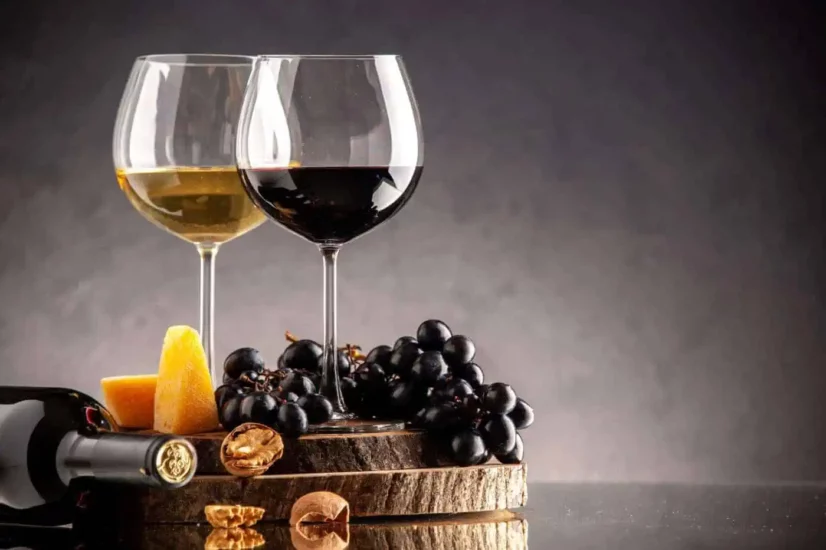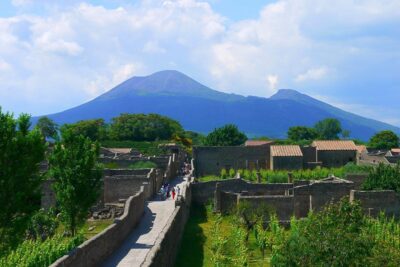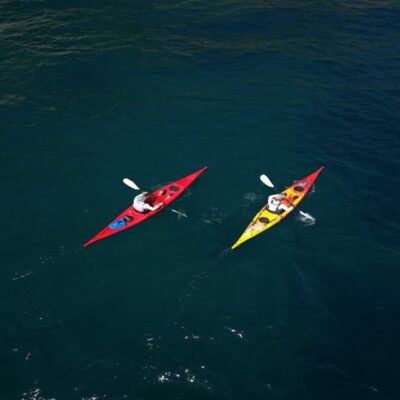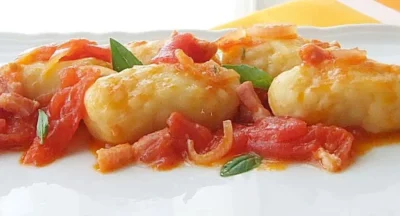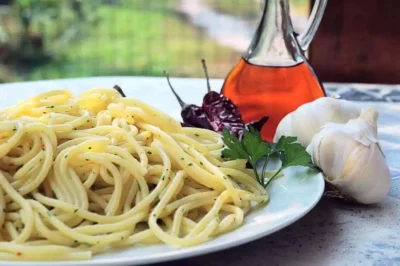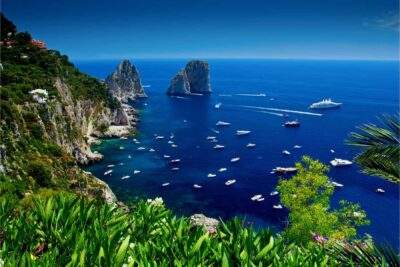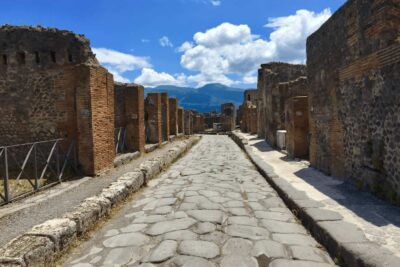Before delving into the fascinating subject of the wines of the Amalfi Coast, let us briefly mention the history of grapes in this magnificent area. The presence of vines along the Amalfi Coast has its roots in the time of Imperial Rome or even earlier.
The terrain on the Amalfi Coast is characterised by spaces that are not very accessible, both in terms of extension and due to the rocky composition of the landscape: for this reason, in the past, vines were planted using other types of plants, such as loquats, almonds and walnuts. The result was a unique orchard mixed with vines, where the various fruits grew together.
It was not until the 11th century, during the Middle Ages, that the vine cultivated on the Amalfi Coast became a source of wealth and conquered a devoted territory, separating itself from the other fruit trees. However, the issue of cramped land and the mostly rocky terrain persisted, so grape cultivation developed on pergolas, along which the shoots could find space and grow.
Even in the absence of a plot of land, grapes were cultivated on the ‘astracum’, the solar atrium of the house, or some part of the riverbed was covered. An indication of the importance of vines in the local economy can also be found in the habit of the Lombards of destroying the vineyards of local populations over which they had the upper hand.
In the past, the grape harvest took place as it does today: the bunches of grapes were picked, washed and then pressed using a wooden press, which was connected to a large vat. The latter could be made of brick or wood: here the juice was collected, which was then stored in wooden barrels and barriques. These containers were then left to rest in a cool, ventilated underground place.
Table of Contents
Amalfitan grape types and indigenous vines
The varieties of wine grapes grown along the Amalfi Coast are Ginestra, Pepella, Ripolo and Fenile for white wines, and Piedirosso, Sciascinoso and Tintore for red and rosé wines.
The climatic conditions of this area are particularly well suited to the cultivation of wine grapes, as can be deduced from the thousands of years of cultivation, which over the centuries have never ceased to produce very fine wines.
📣 We will now analyse the grape varieties from which Amalfi’s fine wines are made, starting with those that lead to the production of white wines.
✅ Ginestra: the first references to this vine date back to as far as 1825, however, this data is not certain, due to its similarity to the Bianca Zita, found in the areas of Furore, Tramonti, Corbara and Positano, which has led to the two vines being confused with each other. Only fifty years later did the Ginestra get the recognition it deserved, this following DNA analysis of the vine, which revealed a relation to the Bianca Zita.
These analyses made it possible to differentiate the two strains. The Ginestra vine is typical of the villages of Amalfi, Maiori, Minori, Scala and Ravello and is characterised by a penetrating scent of ginestra, the flower from which it takes its name.
This vine requires frequent and visible trimming, is hardy and its fruit production is abundant, although the grape clusters are rather small. Once ripe, the berries of the Ginestra grape are not very sugary, while the acidity level is high.
✅ Pepella: This grape variety is cultivated exclusively in the Amalfi inland area and the name ‘Pepella’ is said to derive from the shape of the bunch, as alongside the standard-sized berries, peppercorn-like berries can be found.
The origins of this grape variety are uncertain, but rather recent: it is said to have been introduced in the late 19th century in the municipalities of Tramonti, Ravello and Scala. This grape is not very common. The fruits of the Pepella vine ripen in the second and third decade of September, and the berries have low levels of acidity and sugar.
✅ Ripolo: this grape variety is not very fertile and production is erratic. It is now grown exclusively in the Amalfi area, in limited areas and small vines; however, until the second half of the 19th century it could be found on the slopes of the Lattari Mountains, especially in Pimonte, Gragnano and Castellammare.
The bunch does not have a constant weight, but varies greatly from bunch to bunch and is less than that of other types of grape.
✅ Fenile: this vine is the most popular variety in the South. The grapes of this strain are rather late in ripening, and the harvest takes place between the end of October and the beginning of November: it is the most tardy harvest in Europe.
These grapes are harvested when they have just reached a sufficiently ripe stage, for concern that the late harvest might spoil the crop. It is used in the composition of rosé wines.
📣 Let’s now delve into the grape varieties associated with the production of red wines.
✅ Piedirosso: widely cultivated in the province of Naples, finds its stronghold along the Amalfi Coast. Its name has a unique origin, translating the main characteristic of the grape into an image: Piedirosso (Per’ePalummo in Neapolitan), referring to the red stems of the berries resembling dove’s feet.
Historically, this grape, often confused with Dolcetto d’Alba in the mid-19th century, has low production levels, featuring sweet berries with low acidity.
✅ Sciascinoso: Found throughout the Campania region, Sciascinoso goes by various names, including Sanginosa, Strascinuso, and Olivella. The clusters are notably heavy, with modest sugar levels and relatively high acidity, resulting in a wine with a tangy profile.
✅ Tintore: thriving in the hills of Tramonti, Tintore is named for the abundant coloring substances found beneath its skin. While not highly fertile, the clusters boast good sugar content and total acidity. Cultivation is predominantly done using pergolas.
These red grape varieties contribute to the diverse and flavorful landscape of wines from the Amalfi Coast, each expressing the unique terroir of this captivating region.
The wines of the Amalfi Coast: the three sub-zones Tramonti, Furore and Ravello

The geography of the Amalfi Coast is astonishing because it has two faces: on one side, the sea caresses the rocky coastline, on the other, the mountains extend towards the sky.
Against this scenery, it is impossible not to be struck by the conformation of the terraces: land literally clinging to the mountain, facing the sea.
This unique landscape, the result of technique and real physical sacrifice, finds its maximum expression in the hilly areas of Tramonti, Ravello and Tramonti.
This is probably because the area along the coast has always enjoyed the economic privilege of tourism, while in the hilly area, making a living meant above all working the land and ensuring that it provided the maximum possible to survive.
It is no coincidence that, in ancient times, vines were planted on the macere, the vertical retaining walls, in order to optimise the cultivable space for seasonal fruit and vegetables.
This sort of ‘hidden Costiera’ has found its strength in its intimacy, creating grape types that skilfully blended to create that triumph of quality and uniqueness that distinguishes the wines of the Amalfi Coast.
This is why, although the DOC zone encompasses the entire Amalfi Coast territory, from Vietri sul Mare to Positano, the most commonly known area is the three sub-zones of Furore, Ravello and Tramonti.
✅ The Furore subzone comprises about 35 hectares of vineyards: it seems like a circumscribed area, but one only has to look at a picture of Furore from the other side to understand that the concept of extension is rather relative when speaking of the Amalfi Coast.
We are talking about an area that is characterised by a landscape that evokes emotions that seem to come from the past: the little houses literally disappear into the green of the mountains and one has the impression that there is no real inhabited area. Hence the very evocative appellation of “Paese che non c’è “(“Land that doesn’t exist”), which we will tell you about in detail in an article dedicated to Furore.
Over the years, this conformation has created a sort of isolation, which has perhaps made Furore’s winemakers more careful in the attention they pay to the grapes: perhaps this is what has contributed to the preservation of grapes such as Tronto, Fenile and Pepella.
Speaking of the wines of the Amalfi Coast and, in particular, of Furore, it is impossible not to mention Cantina Marisa Cuomo, a company that produces Furore Bianco, Furore Rosso, Forioduva and Furore Rosso Riserva. We talk about them in detail in an article dedicated to the Wines of Furore.
✅ The Ravello sub-zone includes the wines of Cantine Caruso, officially active since 1896, which produces Gran Caruso, a wine that won awards as far back as 1907 in Massachusetts, 1909 in Brussels and 1911 in Paris.
Today, the historic winery produces two lines: in addition to the historic Gran Caruso, there is also one with the Costa d’Amalfi Doc label.
The Gran Caruso line is produced from unregulated, indigenous grape varieties, often free-range, while for the Costa d’Amalfi label, the grapes are, for the white, Biancolella and Falanghina, for the red, Aglianico and Piedirosso.
Another historic winery in Ravello is Cantina A. Sammarco, established in 1967, which labels the Amalfi Coast DOC wines, Bianco and Rosso, and the Klingsor Garden, in homage to Wagner, who found inspiration at Villa Rufolo. The company also produces table wines, such as Parsifal Bianco (Trebbiano, Falanghina, Greco and Malvasia), sparkling Ravellino (Malvasia and Trebbiano) and white, red and rosé Sammarco.
✅ The Tramonti sub-zone represents, with its five hundred hectares, the most extensive area in the territory, but above all the one with the greatest number of indigenous grape varieties, cultivated on the open ground in centuries-old vineyards.
Among the names of native vines: Pellacchiona, Stepparossa, Tintore, Zaccarina, Capranesca.
Worth mentioning are: ‘E’ Iss’, a pure red Tintore, produced by Tenuta San Francesco in limited quantities from Tintore grapes; the wines of Azienda Agricola Reale (Borgo di Gete, Cardamone, Aliseo and Getis) and those of the Apicella winery, the first to bottle wines in Tramonti.

